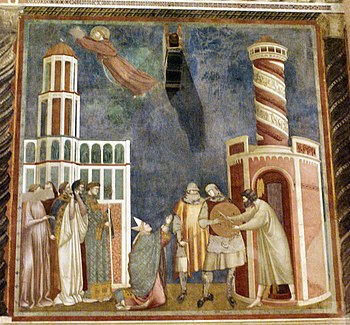Saint Francis cycle in the Upper Church of San Francesco at Assisi
The legend of Saint Francis, as recorded by Thomas of Celano and Bonaventura, is the subject of a cycle of 28 frescoes in the Upper Church of the Basilica di San Francesco in Assisi. They were painted between 1297-1300, at the same time as Giotto's Florentine master, Cimabue painted the walls of the transept.
The authorship of "The Legend of St. Francis", traditionally attributed to Giotto di Bondone, has been disputed by many art historians since 1912. The written records for the monastery's accounts during this period were destroyed around 1800. Tradition has given to Giotto, the best-known naturalistic painter of his period, the authorship of these works, or at the least, the credit for having designed them.
There was, at the time of their creation, an active school of fresco-painters in Rome, whose style, judging by the scant remains, was very much more realistic than the Byzantine imagery of Tuscany, epitomized in the works of Cimabue and Duccio. The best known of the Roman school was Pietro Cavallini, an established master. However, very few frescoes of any sort from this period exist in Rome for comparison, and only a single Roman Church dates from this period. Many older churches were lavishly redecorated in following centuries and frescoes were destroyed.
It is now widely thought that the Upper Church frescoes were painted by at least three separate painters: the Master of Legend of St. Francis (the principal painter and probable supervisor of the cycle), the Master of the Obsequies of St. Francis and the Cecilia Master. A small group with a highly individual style are ascribed to the Isaac painter. Some art historians continue to support the authorship of Giotto and his workshop. from en:Basilica of San Francesco d'Assisi
The Legend of Saint Francis
[edit] |
 |
 |
 |
 |
 |
 |
 |
 |
 |
 |
 |
 |
 |
 |
 |
 |
 |
 |
 |
 |
 |
 |
 |
 |
 |
 |
 |